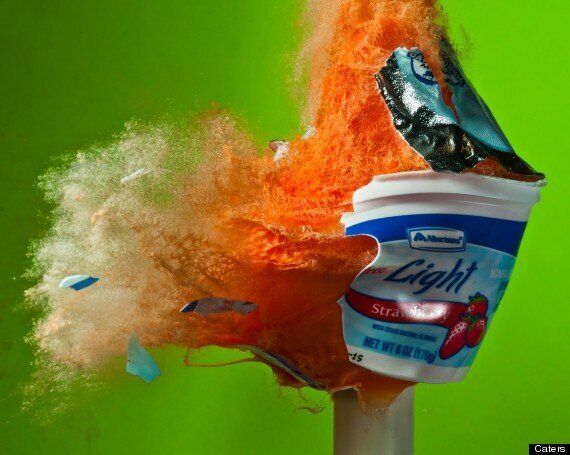
Yogurt: one of the many things Alan Sailer has blown up
These are the incredible images created by a photographer who uses a loaded weapon and explosives to blow up anything from a banana to a bottle of beer.
Photographer Alan Sailer created the dramatic images by blasting food and household objects with a rifle or firecracker, capturing the moment of impact on a homemade camera in his garage.
The 57-year-old bought parts off Ebay to create the £185 camera - which is based on the design of Harold Edgerton - and sets the shutter speed at a one second delay.
He uses then pulls the trigger on an air rifle, firing a bullet into his target at a speed of over 200 metres per second. As the bullet is fired it passes through a sensor which triggers the flash at the exact moment the bullet hits the object.
Alan also uses firecrackers to blow up objects and over the last four years he has shot around 10,000 objects, from fruit and vegetables to ornaments and cameras.
He said: "I love the surprise of high speed photography, of seeing something that you can't see without a fast flash.
"It doesn't happen every session, but it does keep coming up, that "Oh wow" feeling when you peek at the camera display.
"I get many ideas of objects to blow up, I go to garage sales every weekend, to grocery and discount stores and look at things wondering how they would look as targets.
"In my opinion targets that are wet inside and brittle on the outside look the most interesting. I am going for contrast and colour, so if the inside is different than the outside, this helps."
But Alan said each image takes a lot of precision and with the clean up taking longer than the shot it's important to get it right first time.
He said the explosive shots also come with a risk and he often finds himself dodging bullets.
"Shooting things for me is always stressful, I don't much like the noise and mess. The worst, though, is setting up a unique piece to be shot, pulling the trigger and getting a complete failure, no flash. All that work and set-up to get a blank frame and no chance of a re-do.
"Capturing the precise moment is harder, the timing has to be exact. It's trial and error and over time I have got better at it. But anytime I change to a different projectile from a bullet to say a marble, I have to start experimenting with the timing again.
"It is fairly dangerous. The marble has enough energy to kill, but it's not like a bullet. Bullets are fairly small, so they can go through some pretty thick targets. The marble is big and slows down fast when it hits something. I wear a face protector but have not had any worrisome rebounds.
"Luckily I've only had minor injuries so far, I shoot a lot of glass so I can and do get the odd splinter. I protect my eyes very carefully.
But despite it's disadvantages, Alan said he enjoys the element of surprise high-speed photography gives him.
"It's a thrill. I would say that I shoot about five objects to get an image that I am happy enough to post.
"Of these, about one in five is pretty good. Of those about one in ten are really great. I have shot about 10,000 things in the last four years. I have about 20-30 really great pictures.
"Not bad odds for photography."